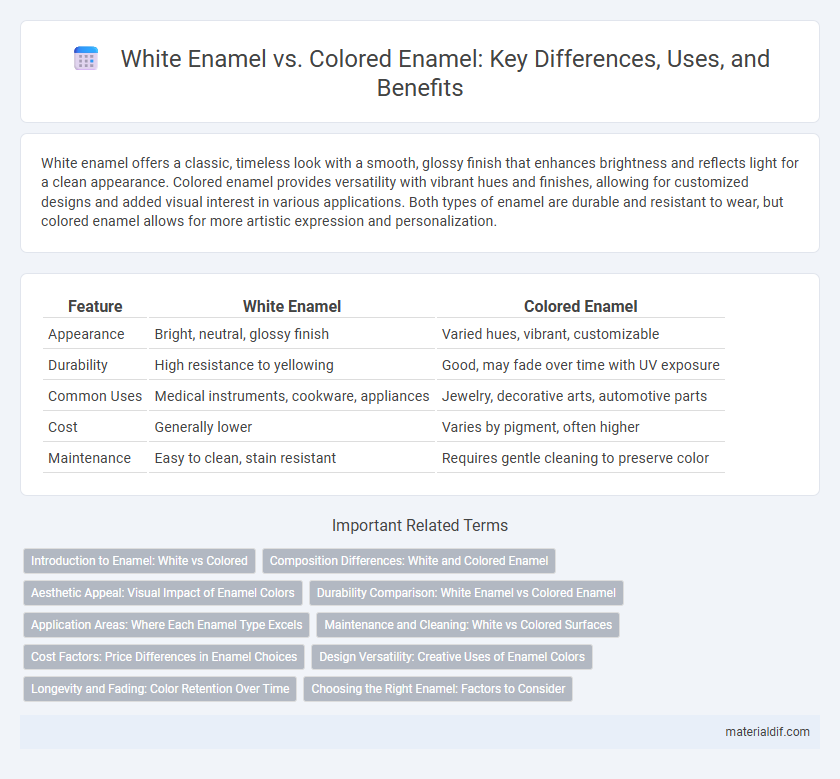White enamel offers a classic, timeless look with a smooth, glossy finish that enhances brightness and reflects light for a clean appearance. Colored enamel provides versatility with vibrant hues and finishes, allowing for customized designs and added visual interest in various applications. Both types of enamel are durable and resistant to wear, but colored enamel allows for more artistic expression and personalization.
Table of Comparison
| Feature | White Enamel | Colored Enamel |
|---|---|---|
| Appearance | Bright, neutral, glossy finish | Varied hues, vibrant, customizable |
| Durability | High resistance to yellowing | Good, may fade over time with UV exposure |
| Common Uses | Medical instruments, cookware, appliances | Jewelry, decorative arts, automotive parts |
| Cost | Generally lower | Varies by pigment, often higher |
| Maintenance | Easy to clean, stain resistant | Requires gentle cleaning to preserve color |
Introduction to Enamel: White vs Colored
White enamel offers a classic, glossy finish known for its durability and resistance to discoloration, making it ideal for traditional jewelry and fine art applications. Colored enamel provides vibrant, customizable hues achieved through incorporating metal oxides, enabling intricate designs with a wide color spectrum. Both types rely on powdered glass fused at high temperatures, but white enamel emphasizes purity and clarity, while colored enamel enhances aesthetic expression through diverse pigmentation.
Composition Differences: White and Colored Enamel
White enamel primarily contains a higher concentration of opaque materials such as tin oxide or zirconium oxide, which create its bright, reflective surface by scattering light effectively. Colored enamel incorporates metal oxides or other pigments like cobalt oxide for blue or chromium oxide for green, which absorb and reflect specific wavelengths to produce vivid hues. The base composition of both white and colored enamels includes silica, fluxes, and stabilizers, but the distinct differences lie in the types and amounts of opacifiers and colorants used to achieve their characteristic appearances.
Aesthetic Appeal: Visual Impact of Enamel Colors
White enamel offers a clean, minimalist aesthetic that highlights design details through its bright, reflective surface, enhancing the overall visual clarity of jewelry and decorative objects. Colored enamel provides a rich palette of hues, allowing for intricate patterns and vibrant contrasts that elevate artistic expression and create striking focal points. The choice between white and colored enamel significantly influences the piece's mood and style, with white conveying purity and simplicity, while colored enamel adds depth and dynamic visual interest.
Durability Comparison: White Enamel vs Colored Enamel
White enamel typically offers higher durability due to its uniform composition and resistance to staining, making it ideal for surfaces exposed to frequent wear. Colored enamel, while providing aesthetic versatility, may be more susceptible to fading and chipping over time, especially under harsh environmental conditions. Research indicates that white enamel coatings maintain structural integrity longer, resulting in extended lifespan for appliances, cookware, and enamel jewelry.
Application Areas: Where Each Enamel Type Excels
White enamel is widely utilized in household appliances, cookware, and medical equipment due to its clean, bright surface that enhances visibility and hygiene. Colored enamel excels in decorative applications, including jewelry, furniture, and architectural elements, providing aesthetic versatility and customization through vibrant hues. The choice between white and colored enamel depends on whether functionality or visual appeal is the primary requirement in the application area.
Maintenance and Cleaning: White vs Colored Surfaces
White enamel surfaces often show stains and discoloration more readily, requiring frequent gentle cleaning with non-abrasive cleaners to maintain brightness. Colored enamel tends to better mask minor dirt and scratches but may need specialized cleaning products to prevent fading or color alteration over time. Proper maintenance includes avoiding harsh chemicals and abrasive materials to preserve the enamel's finish and durability on both white and colored surfaces.
Cost Factors: Price Differences in Enamel Choices
White enamel generally costs less than colored enamel due to simpler manufacturing processes and fewer pigments involved. Colored enamel requires additional materials and complex firing techniques that increase production costs. The price difference can influence decisions in applications like jewelry, coatings, or art where budget and aesthetic preferences intersect.
Design Versatility: Creative Uses of Enamel Colors
White enamel offers a pristine, reflective surface ideal for minimalist and classic designs, enhancing light and contrast in artwork or jewelry. Colored enamel provides a broader palette, allowing intricate patterns, gradients, and vibrant accents that elevate creative expression and customization. This versatility in enamel colors supports diverse applications from fine art to decorative accessories, expanding design possibilities significantly.
Longevity and Fading: Color Retention Over Time
White enamel exhibits superior longevity with minimal fading, maintaining its bright and pristine appearance for decades due to its high resistance to UV radiation and environmental factors. Colored enamel, while offering vibrant and diverse hues, tends to fade more noticeably over time, especially when exposed to prolonged sunlight and harsh weather conditions. Advances in pigment technology and protective coatings have improved color retention in colored enamel but still rarely match the enduring brightness of white enamel.
Choosing the Right Enamel: Factors to Consider
When choosing between white enamel and colored enamel, consider the intended aesthetic, durability, and application surface. White enamel offers a clean, classic look with excellent light reflectivity, ideal for brightening spaces, while colored enamel provides versatile design options and can enhance specific styles or branding needs. Evaluate factors such as UV resistance, ease of maintenance, and compatibility with underlying materials to ensure long-lasting performance and visual appeal.
White enamel vs Colored enamel Infographic

 materialdif.com
materialdif.com